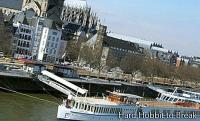
This famous architectural complex of the city of Pomegranate constitutes a precious jewel of the legacy Spanish-Arabic of the XIII and XIV centuries. This emblematic palace, the former residence of the Moorish kings, is located on the plateau of Mount Asabica, towards one end of the city.
The ramparts that surround the palace reach 10 meters high, covering an area of approximately 800 meters long by 500 wide. Like other walled cities, the Alhambra enjoyed autonomy from the city. It had all the necessary services to supply the population that lived there, such as workshops, mosques, schools, etc.
The exquisite decor This palatial city is a true delight for the senses. His magnificent works of plasterwork, in which the Arabs were true masters, and his peculiar way of working marble, make the Alhambra the culmination of art Andalusi.
Most iconic buildings
The Alcazaba . Building intended for defending and surveillance of the enclosure. It is one of the oldest buildings (11th century) and some of its most important elements include:
- Parade
- Tower of tribute. Raised in the highest part of the wall, about 22 meters high and 6 stories high inside. It could have been destined to be a center of defense operations.
- Torre de la Vela. It is the largest defense tower in the entire complex.

Hall of Ambassadors or Hall of Comares. Built in the fourteenth century for hearings deprived of the sultan. It is the widest and highest room in the whole complex. All its walls are richly decorated with floral motifs, stars, shells and plasterwork. The windows were formerly closed by wooden lattices and stained glass windows (coumaries), hence the name of comares. The cubic ceiling of the room is a representation of the Universe according to Muslim culture. Made of cedar wood with star formations at different levels, it is one of the most attractive elements of the room.

Palace of the Lions. Its name is due to the muqar vault that covered it. Religious plaster inscriptions cover the walls of this building. In the interior atrium a gallery formed by 124 marble columns gives way to the Patio de los Leones, famous for the fountain supported on four lions that contain various meanings or symbols.

Hall of the Abencerrajes. Former sultan's bedroom, without windows to the outside but exquisitely decorated. Keep the stucco and original colors. Located in the center of the room, a small fountain served to reflect the dome decorated with muqarnas.

Hall of the two Sisters. Its name comes from the two white marble slabs, located on both sides of the central fountain. They are the largest in the entire Alhambra complex and are equal in weight, size and color. The room has a viewpoint over the city and poems written on the walls.
La Lindaraja viewpoint. Overlooking the garden that bears its name, it is one of the most richly decorated spaces in the entire complex.
Kings Room. It is the longest room in the Harem, possibly intended for family parties. In its central vault the first ten kings of Granada since the foundation of the kingdom are represented, hence the name of the room.

Generalife. Landscaped villa, used by the Muslim kings for rest. It was declared a World Heritage Site.
However, the elements described are only a small sample of the extreme beauty of one of the architectural jewels of our cultural heritage.
VAN CLEEF & ARPELS - COLLECTION PIERRES DE CARACTERE (3) (April 2024)
- World Heritage
- 1,230
















